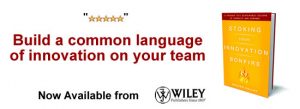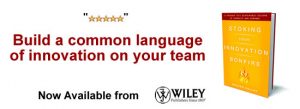Innovating with Constraints
Our October Innovation Contest winners won a signed copy of “7 Lessons for Leading in Crisis” by Bill George and the right to have their article re-published here on Blogging Innovation. Here is the first of the three winning entries:
by Tim Kastelle
I’ve been giving further thought to the issue of public sector innovation which I discussed briefly last week. John and I do a lot of work with people in the public sector as that makes up a fairly big part of Brisbane’s economy, and I know that people often find it difficult to be innovative in that area. However, it is essential that we have good public sector innovation because large parts of our economies are in the public sector, and these parts are often very important. We just can’t afford to have industries like health and education stagnate – innovation is critical in these fields, as it is in the other areas that fall within the public sector.
So what’s the problem? There are a few. One is that overall, the public sector is not viewed as being very dynamic. Consequently, it does not attract a lot of attention from those of us that are interested in innovation. The Australian government is currently undertaking a review to try to devise strategies to improve public sector innovation. The website for this project includes a list of links to resources on public sector innovation (at the bottom of the page) – and you can see that there are not a lot of resources available (the project has a twitter feed too which updates new resources as they find them). This reflects a lack of interest at the levels of both research and policy.
The second issue is that government departments are often fairly risk averse – which makes innovation challenging. This issue is consistently raised by people in our innovation classes that come from the public sector, but it is a common issue for many people in other sectors as well – particularly middle managers that don’t have much scope for action. When I talk to people in this situation they often say that the only way they can be more innovative is if they get more support from top management. It is true that top level support generally helps improve innovation. However, if you are waiting for increased upper management support before you start trying to innovate, in most cases, you’re likely to be waiting for a long time.
 There are a few things you can do to get out of the straightjacket. The main thing is to figure out how to try things. Experimenting is the key to innovating.
There are a few things you can do to get out of the straightjacket. The main thing is to figure out how to try things. Experimenting is the key to innovating.
“The secret of fast progress is inefficiency, fast and furious and numerous failures.” – Kevin Kelly
Now, obviously, failure is not a very popular idea within most government departments. The key to the whole idea though is to figure out ways to generate ideas and discard the ones that don’t work as quickly and cheaply as possible. There are three steps here.
The first is to generate ideas.
“The secret to having good ideas is to have a lot of ideas, then throw the bad ones away.” – Linus Pauling
Usually, this isn’t the problem. People are naturally creative, and the number of untapped ideas that are in your organisation will probably surprise you. One way or another, you need to figure out how to tap into these. If you want some place to start, go to the Tom Peters site and download the Innovation Tactics paper that he has there.
The second step is the tricky one in public sector organisations – you have to select which ideas to try out. The central idea here is to look at how much authority you have. This might be as simple as signing authority – if you can authorise items worth up to $100, then what new ideas can you try to implement for $100 or less? What if you can’t authorise any expenditures? The two jobs in which I’ve been the most innovative have actually both been in the public sector. In the first, I worked out at the start 47 ideas that I thought might make my section run better. Over 18 months, I tried out 45, at a total implementation cost of $0. At the end of that time, my section was just under 20% more effective in turning enquiries into new students, in part as a result of some of those 45 ideas that we tried. Not all of them worked, but a lot of them did – and some of the simplest had the biggest impacts. My bosses weren’t too enthusiastic about new ideas when I started, but they were very enthusiastic about results. Most bosses are. So the second step is to figure out what you can get away with, and start trying things that fall within your scope of power. That’s how select the ideas to try – you may have to wait on the big ones that will change the world, but if you succeed with some small ones, you may eventually get to try those out too.
The final step is getting the ideas that work to spread.
“Some people look for things that went wrong and try to fix them. I look for things that went right, and try to build off them.” – Bob Stone
You need a strategy for amplifying the good ideas. Part of this is selling them to the people around you. To do this, you need to figure out which of the ideas are working. An important activity here is measurement – if you’re able to measure the outcomes of your ideas, it is easier to gain support for trying more things.
Innovating is always hard. It’s especially hard if you don’t feel supported. But the key to innovating when you have constraints is to try things. Try as many as you can, figure out what works, and do more of that. It’s a formula that you can follow in nearly every work setting. Instead of telling me why it won’t work in yours, why don’t you spend the time figuring out a new idea to try yourself instead?
“We have a ‘strategic plan’. It’s called doing things.” – Herb Kelleher (Southwest Airlines)
(photo from flickr/djwudi – creative commons licensed)
 Tim Kastelle is a Lecturer in Innovation Management in the University of Queensland Business School. He blogs about innovation at the Innovation Leadership Network.
Tim Kastelle is a Lecturer in Innovation Management in the University of Queensland Business School. He blogs about innovation at the Innovation Leadership Network.
NEVER MISS ANOTHER NEWSLETTER!
LATEST BLOGS
The Second Coming of the Retail Health Clinic
There used to be a day when you could go to your local barber and get all sorts of wonderful…
Read MoreCan Microsoft out-innovate Google?
Microsoft announced today a round of updates to its Live Search offering. Searchengineland had a good story on the developments.…
Read More


